The Asus ROG Swift PG27UQ G-SYNC HDR Monitor Review: Gaming With All The Bells and Whistles
by Nate Oh on October 2, 2018 10:00 AM EST- Posted in
- Monitors
- Displays
- Asus
- NVIDIA
- G-Sync
- PG27UQ
- ROG Swift PG27UQ
- G-Sync HDR
SDR Color Modes: sRGB and Wide Gamut
Pre-calibration/calibration steps of the monitor is done with SpectraCal’s CalMAN 5 suite. For contrast and brightness, the X-Rite i1DisplayPro colorimeter is used, but for the actual color accuracy readings we use the X-Rite i1Pro spectrophotometer. Pre-calibration measurements were done at 200 nits for sRGB and Wide Gamut with Gamma set to 2.2.
The PG27UQ comes with two color modes for SDR input: 'sRGB' and 'Wide Gamut.' Advertised as DCI-P3 coverage, the actual 'Wide Gamut' sits somewhere between DCI-P3 and BT.2020 HDR, which is right in line with minimum coverages required by DisplayHDR 1000 and UHD Premium. That being the case, the setting isn't directly calibrated to a color gamut, as opposed to sRGB.
Out-of-the-box, the monitor defaults to 8 bits per color, which can be changed in NVIDIA Control Panel. Either way, sRGB accuracy is very good, as the monitor comes factory-calibrated. To note, 10bpc for the PG27UQ is with dithering (8bpc+FRC).
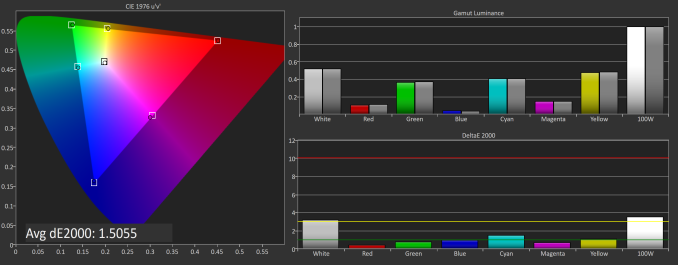
SpectraCal CalMAN sRGB color space for PG27UQ, with out-of-the-box default 8bpc (top) and default with 10bpc (bottom)
In 8bpc or 10bpc, average delta E is around 1.5, which corresponds with the included factory calibration result of 1.62; for reference, for color accuracy a dE below 1.0 is generally imperceptible and a dE below 3.0 is considered accurate.
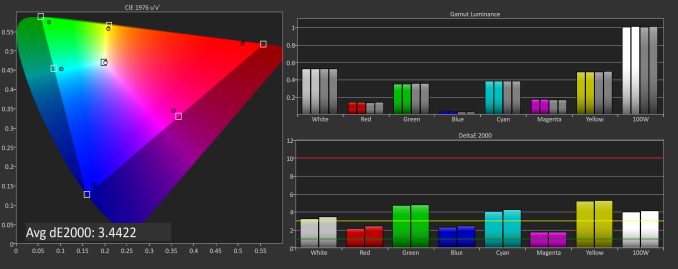 SpectraCal CalMAN DCI-P3 (above) and BT.2020 (below) color spaces for PG27UQ, on default settings with 10bpc and 'wide color gamut' enabled under SDR Input
SpectraCal CalMAN DCI-P3 (above) and BT.2020 (below) color spaces for PG27UQ, on default settings with 10bpc and 'wide color gamut' enabled under SDR Input
The 'wide gamut' options are not mapped to either DCI-P3 or BT.2020, sitting somewhere in between, but then again, it doesn't need to be as a professional or prosumer monitor would.
Grayscale and Saturation
Looking at color accuracy more throughly, we look at greyscale and saturation readings with respect to the sRGB gamut. The dips in gamma aren't perfect, and the whitepoints are a little on the warm side.
 SpectraCal CalMAN sRGB color space grayscales with out-of-the-box default 8bpc (top) and default with 10bpc (bottom)
SpectraCal CalMAN sRGB color space grayscales with out-of-the-box default 8bpc (top) and default with 10bpc (bottom)
The saturation numbers are better, and in fact the dE is around 1.5 to 1.4, which is impressive for a gaming monitor.
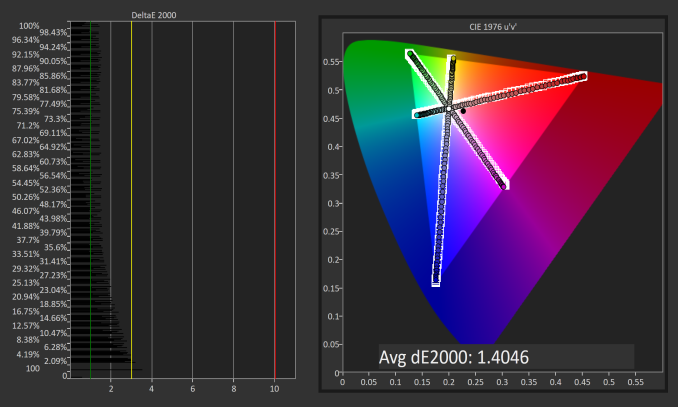 SpectraCal CalMAN sRGB color space saturation sweeps for PG27UQ, with out-of-the-box default 8bpc (top) and default with 10bpc (bottom)
SpectraCal CalMAN sRGB color space saturation sweeps for PG27UQ, with out-of-the-box default 8bpc (top) and default with 10bpc (bottom)
Gretag Macbeth (GMB) and Color Comparator
The last color accuracy test is the most thorough, and again the PG27UQ shines with dE of 1.53 and 1.63
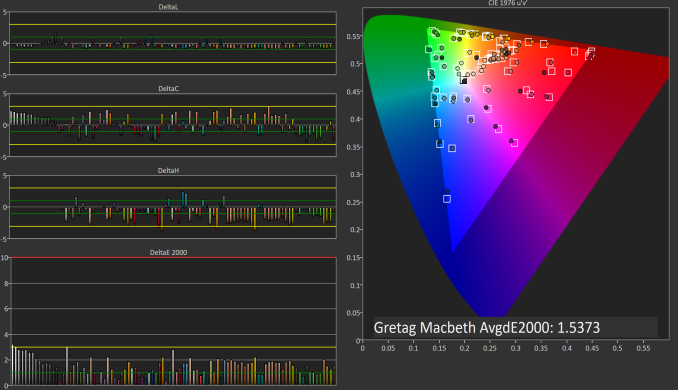 SpectraCal CalMAN sRGB color space GMB for PG27UQ, with out-of-the-box default 8bpc (top) and default with 10bpc (bottom)
SpectraCal CalMAN sRGB color space GMB for PG27UQ, with out-of-the-box default 8bpc (top) and default with 10bpc (bottom)
Considering that this monitor was not designed for professional use, it's very calibrated out-of-the-box for gamers, and there's no strong concern for calibration. If anything, users should just be sure to select 10bpc in the NVIDIA Control Panel, but even then most games use 8bpc anyhow.

 SpectraCal CalMAN sRGB relative color comparator graphs for PG27UQ, with out-of-the-box default 8bpc (top) and default with 10bpc (bottom). Each color column is split into halves; the top half is the PG27UQ's reproduction and the bottom half is the correct value
SpectraCal CalMAN sRGB relative color comparator graphs for PG27UQ, with out-of-the-box default 8bpc (top) and default with 10bpc (bottom). Each color column is split into halves; the top half is the PG27UQ's reproduction and the bottom half is the correct value


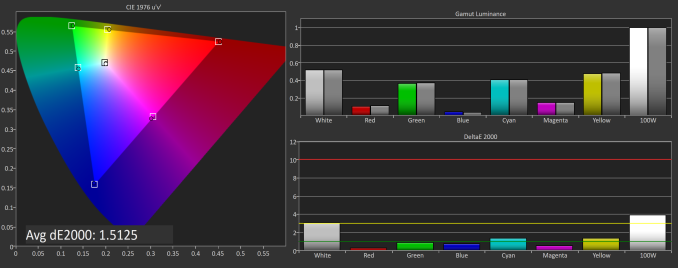
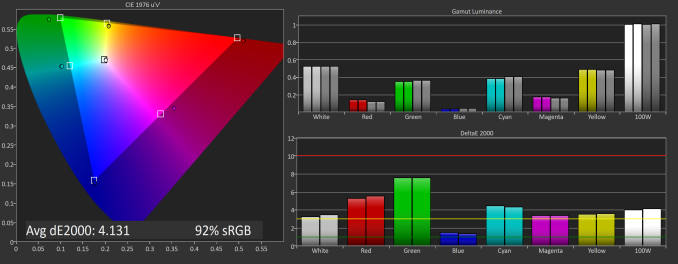
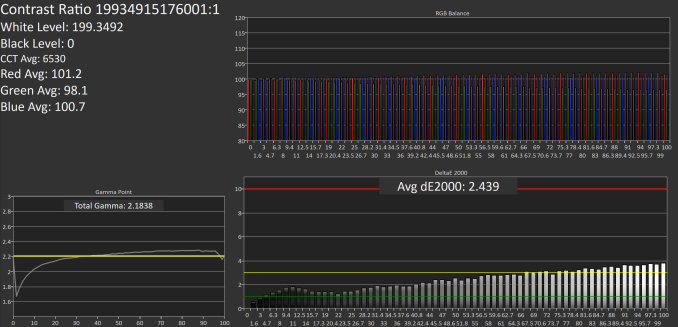
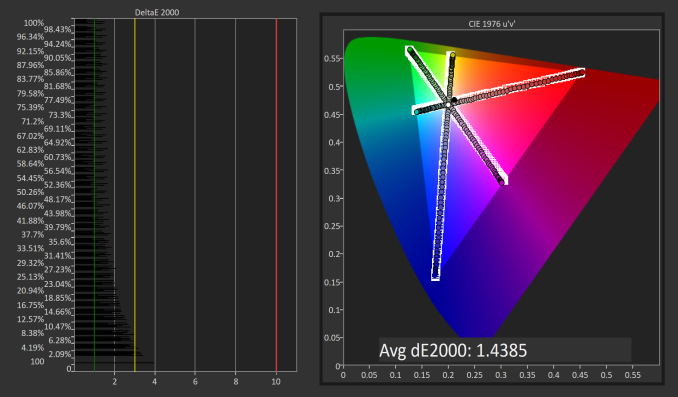
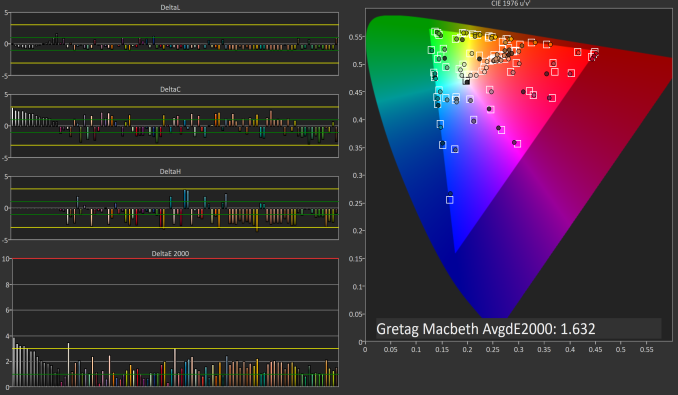








91 Comments
View All Comments
Flunk - Tuesday, October 2, 2018 - link
I'd really like one of these, but I can't really justify $2000 because I know that in 6-months to a year competition will arrive that severely undercuts this price.imaheadcase - Tuesday, October 2, 2018 - link
That's just technology in general. But keep a eye out, around that time this monitor is coming out with a revision that will remove the "gaming" features" but still maintain refresh rate and size.edzieba - Tuesday, October 2, 2018 - link
The big omission to watch out for is the FALD backlight. Without that, HDR cannot be achieved outside of an OLED panel (and even then OLED cannot yet meet the peak luminance levels). You;re going to see a lot of monitors that are effectively SDR panels with the brightness turned up, and sold as 'HDR'. If you're old enough to remember when HDTV was rolling uout, remember the wave of budget 'HD' TVs that used SD panels but accepted and downsampled HD inputs? Same situation here.Hixbot - Tuesday, October 2, 2018 - link
Pretty sure edgelit displays can hit the higher gamut by using a quantom dot filter.DanNeely - Tuesday, October 2, 2018 - link
quantum dots increase the color gamut, HDR is about increasing the luminescence range on screen at any time. Edge lit displays only have a handful of dimming zones at most (no way to get more when your control consists of only 1 configurable value per row/column). You need back lighting where each small chunk of the screen can be controlled independently to get anything approaching a decent result. Per pixel is best, but only doable with OLED or jumbotron size displays. (MicroLED - we can barely make normal LEDs small enough for this scale.) OTOH if costs can be brought down microLED does have the potential to power a FALD backlight with an order of magnitude or more more dimming zones than current models LCD can do; enough to largely make halo effects around bright objects a negligible issue.Lolimaster - Tuesday, October 2, 2018 - link
There is also miniled that will replace regular led for the backlight.Microled = OLED competition
Miniled up to 50,000zones (cheap "premium phones" will come with 48zones).
crimsonson - Tuesday, October 2, 2018 - link
I think you are exaggerating a bit. HDR is just a transform function. There are several standards that say what the peak luminance should be to considered HDR10 or Dolby Vision etc. But that itself is misleading.Define " (and even then OLED cannot yet meet the peak luminance levels)"
Because OLED can def reach 600+ nits, which is one of the standards for HDR being proposed.
edzieba - Tuesday, October 2, 2018 - link
"HDR is just a transform function"Just A transform function? [Laughs in Hybrid Log Gamma],
Joking aside, HDR is also a set of minimum requirements. Claiming panels that do not even come close to meeting those requirements are also HDR is akin to claiming that 720x468 is HD, because "it's just a resolution". The requirements range far beyond just peak luminance levels, which is why merely slapping a big-ass backlight to a panel and claiming it is 'HDR' is nonsense.
crimsonson - Wednesday, October 3, 2018 - link
"Just A transform function? [Laughs in Hybrid Log Gamma],"
And HLG is again just a standard of how to handle HDR and SDR. It is not required or needed to display HDR images.
"HDR is also a set of minimum requirements"
No, there are STANDARDS that attempts to address HDR features across products and in video production. But in itself does not mean violating those standards equate to a non-HDR image. Dolby Vision, for example, supports dynamic metadata. HDR10 does not. Does that make HDR10 NOT HDR?
Eventually, the market and the industry to congregate behind 1 or 2 SET of standards (since it is not only about 1 number or feature). But we are not there yet. Far from it.
Since you like referencing these standards, you do know that Vesa has HDR standards as low as 400 and 600 nits right?
And I think you are conflating wide gamut vs Dynamic Range. FALD is not needed to achieve wide gamut.
And using HD to illustrate your points exemplifies you don't understand how standards work in broadcast and manufacturing.
edzieba - Thursday, October 4, 2018 - link
"And HLG is again just a standard of how to handle HDR and SDR. It is not required or needed to display HDR images."The joke was that there are already at least 3 standards of HDR transfer functions, and some (e.g. Dolby Vision) allow for on the fly modification of the transfer function.
"And I think you are conflating wide gamut vs Dynamic Range. FALD is not needed to achieve wide gamut."
Nobody mentioned gamut. High Dynamic Range requires, as the name implies, a high dynamic range. LCD panels cannot achieve that high dynamic range on their own, they need a segmented backlight modulator to do so.
As much as marketers would want you to believe otherwise, a straight LCD panel with an edge-lit backlight is not going to provide HDR.
"And using HD to illustrate your points exemplifies you don't understand how standards work in broadcast and manufacturing."
Remember how "HD ready" was brought in to address exactly the same problem of devices marketing capabilities they did not have? And how it brought complaints about allowing 720p devices to also advertise themselves as "HD Ready"? Is this not analogous to the current situation where HDR is being erroneously applied to panels that cannot achieve it, and how VESA's DisplayHDR has complaints that anything below Display HDR1000 is basically worthless?